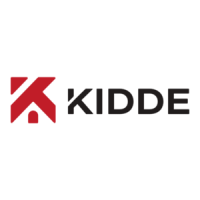Installation
April 2020 4-2 06-237619-001
4-2 INSTALLATION PROCESS
When installing, follow this general process:
1. Install all System Piping, including Selector valves if applicable.
2. Pressurize the pipe network per local applicable standards. Blow out any debris in the piping
once done.
3. Install the Nozzles and traps.
4. Install the cylinder manifold. If applicable, install the back-plate manifold as well.
5. Install discharge hoses to the manifold.
6. Install the cylinder racking components.
7. Secure the cylinders to the racking system.
8. Connect pilot actuation line and discharge hoses.
9. Install the release unit and slave cylinder gauge assemblies.
Note: Do not install the pilot line actuation hose from release unit to rear of valve, this should
be performed during commissioning.
10. Install the detection and control systems (not supplied by Kidde Fire Systems) per manu-
facturer’s instructions.
11. Commission the system.
4-3 TECHNICAL DESCRIPTION
Items to be supplied locally (excluded from normal scope of supply) include bolts for supports,
distribution pipes and fittings as well as supports for pipe installation.
The Agent cylinder bank must be installed and assembled as indicated on the relevant
drawings. For details of individual components please refer to the relevant datasheet and/or
installation instruction.
The system generally consists of the following main components:
• Distribution manifold arrangement with manifold check valves
• Agent cylinders with valves
• Solenoid release units with pressure gauge and switch
• Slave cylinder pressure gauge with switch
• Discharge hoses
• Actuation hoses with quick-connect fittings
•Discharge nozzles
The solenoid actuator valve and the contact gauges for slave cylinders (on one loop) are
connected to the fire release and control panel either directly or via a junction box.
The contact gauge on the release unit and all slave cylinders are joined together using “quick
connect” cable joints, the lead from the master cylinder is then wired into a junction box which
in turn is wired to the control panel.
4-4 FUNCTIONAL DESCRIPTION
The Agent cylinder valve is kept shut by the cylinder pressure and will remain open once
operated until the cylinder is almost empty or pressure is removed from the pilot actuation line.
The system can be released in the following ways:
• Automatic release: By a signal from the fire alarm & control panel, initiated by detectors
installed in the protected area.
• Manual release: In the unlikely event of a complete electrical failure to the system, actua-
tion may be accomplished by operating the manual actuator on the Master cylinder valve’s
release unit. For multiple area systems, open the appropriate 2-way solenoid valve on the
backplate manifold manually before operating the release unit. For more information, see
Chapter 5.

